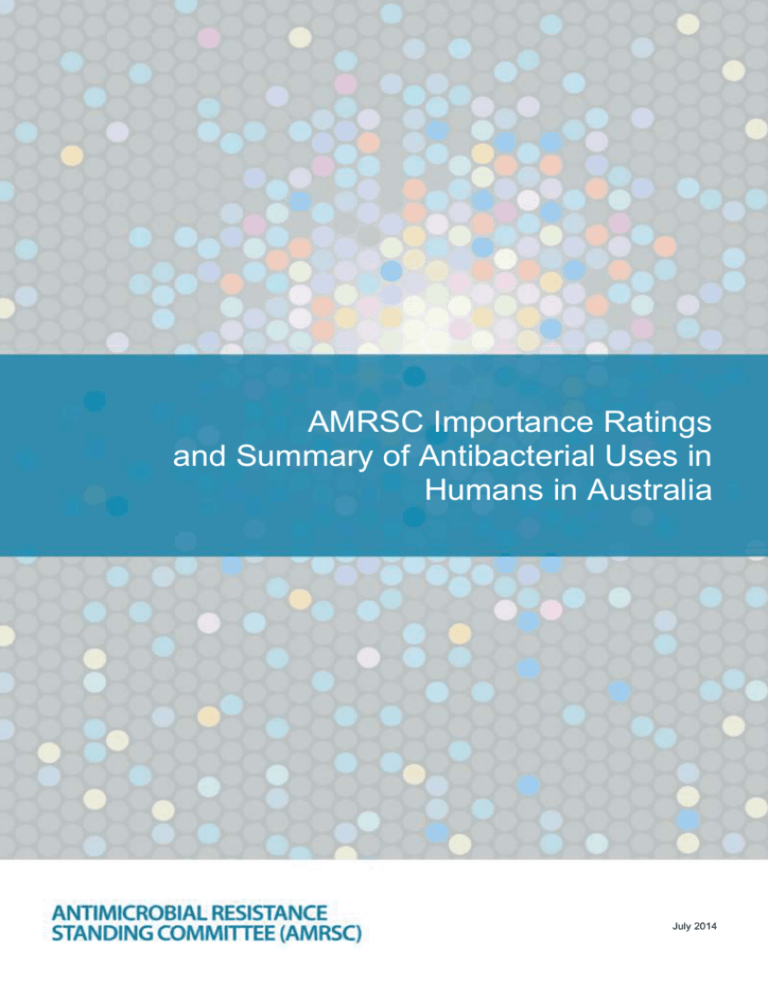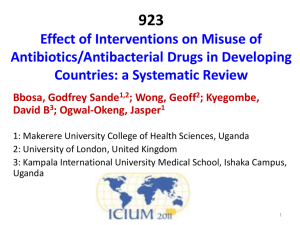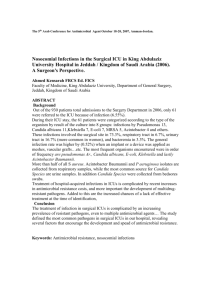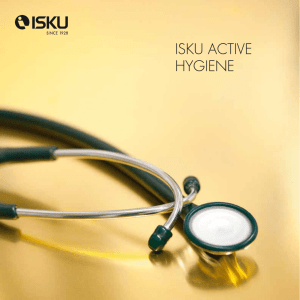Importance Ratings and Summary of Antibacterial Uses in Humans
advertisement

AMRSC Importance Ratings and Summary of Antibacterial Uses in Humans in Australia July 2014 ISBN: Print: 978-1-921983-72-6 Electronic: 978-1-921983-73-3 © Commonwealth of Australia 2014 This work is copyright. It may be reproduced in whole or in part for study or training purposes subject to the inclusion of a n acknowledgement of the source. Requests and inquiries concerning reproduction and rights for purposes other than those indicated above requires the written permission of the Australian Commission on Safety and Quality in Health Care: Australian Commission on Safety and Quality in Health Care GPO Box 5480 Sydney NSW 2001 Email: mail@safetyandquality.gov.au Acknowledgements This document was prepared by the Australian Commission on Safety and Quality in Health Care in collaboration with numerous expert working groups, members of the Commission’s standing committees, and individuals who generously gave of their time and expertise. AMRSC Antimicrobial Resistance Standing Committee AMRSC Importance Ratings and Summary of Antibacterial Uses in Humans in Australia 2 Contents Preface 4 Background 5 Purpose 5 Table 1 Antibacterial agents used in human health in Australia 6 Table 2 Antibacterials not included in Table 1 but with the potential to select for cross resistance to antibacterials used in Table 1 15 AMRSC Antimicrobial Resistance Standing Committee AMRSC Importance Ratings and Summary of Antibacterial Uses in Humans in Australia 3 Preface The AMRSC Importance Ratings and Summary of Antibacterial Uses in Humans in Australia (the “Antibacterial Importance Ratings”) has been updated by the Antimicrobial Resistance Standing Committee (AMRSC) and endorsed by the Australian Health Protection Principal Committee (AHPPC). Its purpose is to provide guidance to clinicians and the pharmaceutical industry about the importance of antibacterial agents available for human use in Australia. The Antibacterial Importance Ratings capture the knowledge of experienced professionals and is based upon the best available evidence at the time of completion. Readers should not rely solely on the information contained within this document. Antibacterial Importance Ratings is not intended to be a substitute for advice from other relevant sources including, but not limited to, the advice from a health professional. Clinical judgment and discretion may be required in the interpretation and application of this information. The membership of the AMRSC and the AHPPC, and the Australian Government as represented by the Department of Health do not warrant or represent that the information contained in Antibacterial Importance Ratings is accurate, current or complete. The AMRSC, the AHPPC and the Australian Government do not accept any legal liability or responsibility for any loss, damages, costs or expenses incurred by the use of, or reliance on, or interpretation of, the information contained in the Antibacterial Importance Ratings. Endorsed by: Australian Antimicrobial Resistance Standing Committee September 2013 Australian Health Protection Principal Committee April 2014 Released by the Department of Health July 2014 AMRSC Antimicrobial Resistance Standing Committee AMRSC Importance Ratings and Summary of Antibacterial Uses in Humans in Australia 4 Background Earlier versions of this document were developed by the Expert Advisory Group on Antimicrobial Resistance (EAGAR) of the National Health and Medical Research Council (NHMRC). Part of EAGAR’s role was to provide advice to Australian governments and their agencies on risk minimisation strategies for controlling antimicrobial resistance in Australia. As part of this activity, EAGAR provided advice on risk assessments for new antimicrobials and extensions of indications of currently registered antibiotics. The importance of the antimicrobial or class of antimicrobials in human medicine was taken into account in these risk assessments. The Antimicrobial Resistance Standing Committee (AMRSC) of the Australian Health Protection Principal Committee was formed in 2012. It agreed to update the importance ratings as the ratings provide valuable assistance to federal government agencies, especially those with regulatory roles. AMRSC is aware of documents with similar purposes including the WHO document ‘Critically Important Antimicrobials for Human Medicine, 3rd rev, 2011’ and the OIE ‘List of Antimicrobials of Veterinary Importance’. AMRSC takes these documents into consideration when allocating its ratings, and has in some circumstances given a different rating because of the Australian context. Purpose This table is intended to provide guidance to clinicians and the pharmaceutical industry (human and animal) about the importance of the various antibacterial agents available for human use in Australia. The term ‘antibacterial’ is preferred in this document as the term ‘antimicrobial’ technically includes agents without antibacterial properties and such agents are not addressed here. If an antibacterial is classified as “High” it implies that if resistance develops there will be very limited or in some cases no alternatives available to treat serious bacterial infections. Details are also given on the current ways in which antibacterials are used in humans. This list is for guidance only, and does not include every use of the agent or class. All agents with significant antibacterial activity are included in the table, even if their primary use is for other than treatment of bacterial infections (e.g. pyrimethamine, a dihydrofolate reductase inhibitor whose main role is treatment of malaria and toxoplasmosis, but with the same antibacterial activity as trimethoprim and therefore has the potential to select for resistance to this class). AMRSC uses this information as a guide in providing advice to regulatory agencies and government committees including the APVMA (Australian Pesticides and Veterinary Medicines Authority), TGA (Therapeutic Goods Administration), NDPSC (National Drugs and Poisons Schedule Committee) and the PBAC (Pharmaceutical Benefits Advisory Committee), as a method of assessing the risk to human health after exposure of susceptible humans to either an antibiotic or antibiotic-resistant bacteria. In risk assessment terms, this table is relevant to the ‘severity of impact’ which is an important element to overall risk characterisation. As an example, if an antibiotic is rated as “High”, AMRSC would consider that the severity of impact caused by bacteria resistant to that antibacterial is high, as there are few or no alternatives to many infections. Rating in this table does not affect other parts of risk assessment including hazard, exposure, impact or probability of disease as a result of exposure. AMRSC ratings will change over time as resistance levels change, new drugs are introduced, and optimum drug choices alter because of new medical evidence. Consequently the table will be updated at regular intervals. AMRSC Antimicrobial Resistance Standing Committee AMRSC Importance Ratings and Summary of Antibacterial Uses in Humans in Australia 5 Table 1 Antibacterial agents used in human health in Australia Antibacterial class and antibacterial AMRSC Uses P, T, R Comments Importance Rating1 APVMA registered Narrow-spectrum penicillins Benzylpenicillin (pen G) Low and phenoxymethylpenicillin (pen V) P2, T3, R1 Primary agents in pneumococcal and streptococcal infection Procaine penicillin Low P2, T3, R1 Intramuscular – occasional substitute for benzylpenicillin Yes Benzathine penicillin Low P3, T3, R1 Intramuscular – syphilis treatment and rheumatic fever prophylaxis Yes P2, T3, R1 Principal role in respiratory tract infections; widespread IV hospital use in combination for a range of moderate and serious infections. Surgical and endocarditis prophylaxis Yes P3, T3, R1 Standard treatment for Staphylococcus aureus infections (not MRSA). Surgical prophylaxis, especially orthopaedics Yes (Cloxacillin) P1, T3, R1 Second line agent for respiratory Yes tract infections; role in certain types of skin/soft tissue infections and mixed staphylococcal/Gramnegative infections and aerobic/anaerobic infections. Moderate-spectrum penicillins Amoxycillin and ampicillin Low Antistaphylococcal penicillins Cloxacillin, dicloxacillin and flucloxacillin (methicillin) Medium ß-lactamase inhibitor combinations Amoxycillin-clavulanate Medium AMRSC Antimicrobial Resistance Standing Committee AMRSC Importance Ratings and Summary of Antibacterial Uses in Humans in Australia 6 Table 1 (continued) Antibacterial class and antibacterial AMRSC Uses P, T, R Comments Importance Rating1 Ticarcillin-clavulanate and Piperacillintazobactam High APVMA registered P1, T2, R2 Primary agents for Pseudomonas aeruginosa Valuable agents for a range of severe mixed aerobicanaerobic infections including intraabdominal infections, aspiration pneumonia, skin/soft tissue infections. Neutropenic sepsis. P3, T3, R1 Treatment of minor and staphylococcal infections in penicillin allergic patients. Prophylaxis in orthopaedic and other surgery. Yes (Cephalexin) Medium P0, T2, R1 Treatment of respiratory infections in penicillin-allergic patients Yes (Cefuroxime) Medium P3, T1, R2 Useful anti-anaerobic activity, major role in surgical prophylaxis 1st Generation Cephalosporins Cephalexin, cephalothin and cephazolin Medium 2nd Generation Cephalosporins Cefaclor and cefuroxime-axetil Cephamycins Cefoxitin 3rd Generation Cephalosporins Ceftriaxone High P2, T3, R2 Major agent in severe pneumonia and meningitis. Used in selected cases for treatment of gonorrhoea and alternative for prophylaxis of meningococcal infection Cefotaxime High P0, T3, R2 Major agent in severe pneumonia and meningitis 4th Generation Cephalosporins (and anti pseudomonal) Ceftazidime and cefepime High AMRSC Antimicrobial Resistance Standing Committee P1, T3, R3 Restricted role in pseudomonal infection and neutropenic sepsis AMRSC Importance Ratings and Summary of Antibacterial Uses in Humans in Australia 7 Antibacterial class and antibacterial AMRSC Uses P, T, R Comments Importance Rating1 APVMA registered Anti-MRSA Cephalosporins Ceftaroline High P1, T1, R3 Restricted role in MRSA infection Imipenem, meropenem, High doripenem and ertapenem P0, T3, R4 Very broad-spectrum reserve agents for multi-resistant and serious Gram-negative and mixed infections High P0, T3, R4 Reserve agents for resistant Gramnegative infections or patients with severe ß-lactam allergy Low P2, T3, R1 Major agents for minor respiratory tract infections and acne. Supportive role in pneumonia for treating Mycoplasma and Chlamydia pneumoniae. Malaria prophylaxis (doxycycline) High P0, T1, R4 Reserve agent for multi-resistant gram-positives and some multiresistant gram-negatives Vancomycin High P2, T3, R2 Drug of choice for serious methicillin-resistant staphylococcal infections. Reserve agent for enterococcal infection when there is resistance or penicillin allergy Teicoplanin High P1, T1, R4 Substitute for vancomycin if intolerance or outpatient IV therapy Carbapenems Monobactams Aztreonam Tetracyclines Doxycycline, minocycline (and demeclocycline) Yes (Doxycycline) Glycylcyclines Tigecycline Glycopeptides AMRSC Antimicrobial Resistance Standing Committee AMRSC Importance Ratings and Summary of Antibacterial Uses in Humans in Australia 8 Antibacterial class and antibacterial AMRSC Uses P, T, R Comments Importance Rating1 APVMA registered Neomycin (including framycetin) Low P1, T2, R1 Topical agent for skin infection and gut suppression Yes Gentamicin and tobramycin Medium P2, T3, R1 Standard agents in combination for Yes (Gentamicin) serious and pseudomonal infection. Gentamicin used in combination for endocarditis Amikacin High P0, T2, R4 Reserve agents for Gram-negatives resistant to gentamicin and tobramycin Spectinomycin Medium P0, T2, R5 Spectinomycin only used for gonorrhoea (infrequently) Yes Streptomycin Low P0, T1, R5 Rare use in treatment of TB and enterococcal endocarditis Yes Capreomycin Low P0, T1, R5 Rare use in TB Paromomycin Low P0, T1, R5 Rare use for Cryptosporidium and Dientamoeba infection Aminoglycosides Sulfonamides and DHFR inhibitors Sulfadiazine Low P0, T3, R4 Treatment of acute toxoplasmosis Yes Sulfacetamide Low P0, T3, R1 Treatment of conjunctivitis Yes Trimethoprim Low P2, T3, R1 Treatment and prophylaxis of UTI Yes Trimethoprimsulfamethoxazole (cotrimoxazole) Medium P2, T3, R1 Minor infections, especially treatment and prophylaxis of UTI. Standard for treatment and prophylaxis of Pneumocystis carinii AMRSC Antimicrobial Resistance Standing Committee AMRSC Importance Ratings and Summary of Antibacterial Uses in Humans in Australia 9 Antibacterial class and antibacterial AMRSC Uses P, T, R Comments Importance Rating1 APVMA registered infection and nocardiasis. Important for community-acquired MRSA infections Sulfadoxinepyrimethamine Low P1, T1, R3 Treatment and prophylaxis of malaria Proguanil Low P2, T1, R3 Malaria prophylaxis High P0, T1, R4 Treatment of multi-resistant Grampositive infections, especially MRSA and VRE Azithromycin Low P3, T3, R2 Treatment of Chlamydia trachomatis infections. Major agent fortreatment and suppression of atypical mycobacterial infection Clarithromycin Low P2, T2, R1 Treatment of minor Gram-positive infections. Major agent for treatment and suppression of atypical mycobacterial infection Erythromycin and roxithromycin Low P1, T3, R1 Treatment of minor Gram-positive, Chlamydia and Mycoplasma infections. Yes (Erythromycin) Spiramycin Low P0, T1, R5 Treatment of toxoplasmosis in pregnancy Yes Medium P1, T3, R2 Reserved for Gram-positive and anaerobic infections in penicillinallergic patients. Clindamycin topical used for acne Yes Oxazolidinones Linezolid Macrolides Lincosamides Clindamycin and lincomycin AMRSC Antimicrobial Resistance Standing Committee AMRSC Importance Ratings and Summary of Antibacterial Uses in Humans in Australia 10 Antibacterial class and antibacterial AMRSC Uses P, T, R Comments Importance Rating1 APVMA registered Streptogramins Quinupristin with dalfopristin High P0, T1, R4 Reserve agent for multi-resistant Gram-positive infections (MRSA and vancomycin-resistant Enterococcus faecium) Pristinamycin High P0, T1, R5 As for quinupristin-dalfopristin Medium P2, T3, R1 Major agents for the treatment and Yes (Metronidazole) prevention of anaerobic Infections in hospitals. Principal agents for the treatment of giardiasis and trichomoniasis Norfloxacin High P1, T3, R2 Treatment and prevention of complicated UTI Ciprofloxacin High P2, T3, R3 Major oral agent for the treatment of Gram-negative infections resistant to other agents. Minor role in meningococcal prophylaxis Moxifloxacin High P0, T3, R4 Restricted role in the management of serious respiratory infections, especially pneumonia in patients with severe penicillin allergy Ofloxacin High P0, T2, R3 Topical treatment of severe eye infections High P2, T3, R4 Primary agent for treatment and prevention of tuberculosis Nitroimidazoles Metronidazole and tinidazole Quinolones Antimycobacterials Isoniazid AMRSC Antimicrobial Resistance Standing Committee AMRSC Importance Ratings and Summary of Antibacterial Uses in Humans in Australia 11 Antibacterial class and antibacterial AMRSC Uses P, T, R Comments Importance Rating1 APVMA registered Ethambutol and pyrazinamide High P1, T3, R4 Primary agent for treatment of TB Cycloserine, pHigh aminosalicylic acid, and prothionamide P0, T1, R4 Reserve agents for complicated or resistant TB High P0, T3, R4 Usage predominantly for treatment of leprosy Rifampicin (Rifampin) High P3, T3, R2 Meningococcal and H. influenzae type b prophylaxis; Standard part of TB regimens; Important oral agent in combination for MRSA infections Rifabutin High P3, T2, R4 Treatment and prophylaxis of Mycobacterium avium complex infections Rifaximin High P1, T0, R4 Prevention of hepatic encephalopathy Low P0, T2, R1 Topical agents with Gram-positive activity Yes (Bacitracin) Polymyxin B High P0, T2, R1 Topical agent with Gram-negative activity Yes Colistin High P0, T1, R2 Reserve agent for very multiresistant gram-negative infection (both inhaled and intravenous) Antileprotics Clofazimine and dapsone Rifamycins Polypeptides Bacitracin and gramicidin Polymyxins AMRSC Antimicrobial Resistance Standing Committee AMRSC Importance Ratings and Summary of Antibacterial Uses in Humans in Australia 12 Antibacterial class and antibacterial AMRSC Uses P, T, R Comments Importance Rating1 APVMA registered Amphenicols Chloramphenicol Low P0, T2, R1 Usage largely as topical eye Yes preparation. Occasional need for the treatment of bacterial meningitis High P2, T2, R1 Treatment and prophylaxis of urinary tract infections only High P0, T3, R2 Used in combination therapy with rifampicin for MRSA High P0, T1, R5 Medium P1, T3, R1 Nitrofurans Nitrofurantoin Fusidanes Sodium fusidate Yes Fosfomycins Fosfomycin Pseudomonic acids Mupirocin Topical treatment of skin infections and clearance of S. aureus nasal carriage (including MRSA) Lipopeptides Daptomycin 1 High Reserve agent for serious MRSA and VRE iReserve agent for serious MRSA and VRE infecftions The importance of the drug class to the treatment of infections in humans, and the seriousness of the consequences of emergence of resistance. Abbreviations: UTI = urinary tract infections; TB = tuberculosis. MRSA = methicillin-resistant Staphylococcus aureus; VRE = vancomycin resistant Enterococcus species AMRSC Antimicrobial Resistance Standing Committee AMRSC Importance Ratings and Summary of Antibacterial Uses in Humans in Australia 13 Legend for Table 1 AMRSC Importance Rating High These are essential antibiotics for treatment of human infections where there are few or no alternatives for many infections. Also have been called “critical”, “last-resort” or “last-line” antibiotics. Medium There are other alternatives available but less than for those classified as Low. Low There are a reasonable number of alternative agents in different classes are available to treat most infections even if antibiotic resistance develops. Human Uses These reflect the current use of these antibiotics in Australia in human medicine. P: prophylactic use 0 = not recommended for prophylactic use; 1 = rarely used; 2 = moderate; 3 = frequent or major use T: therapeutic use 0 = not used for treatment; 1 = infrequently used for listed indications; 2 = moderate use for listed indications; 3 = used frequently for listed indications R = Restriction on use (Pharmaceutical Benefits Scheme or hospitals) 1 = readily available 2 = some extra rules on use e.g. ‘Restricted benefit’ in the Pharmaceutical Benefits Scheme (PBS) or not listed on the PBS and therefore not subsidised 3 = higher level of restriction e.g. needs an ‘Authority required’ prescription on the PBS or not listed on the PBS and therefore not subsidised; often restricted use in hospitals 4 = use severely restricted (e.g. not available for prescription under PBS, available in major hospitals but only with permission from microbiologist or infectious diseases consultant, or in a special clinic) 5 = not TGA registered but imported under the SAS scheme Antibacterial drug classes which are not used in humans and with no cross-resistance known to classes of antibacterials used in humans include arsenicals (roxarsone, 3-nitro-4-hydroxyphenylarsonic acid, sodium arsenilate), bambermycins (flavophospholipol, flavomycin), bicozamycin, coumermycins (including novobiocin), ionophores (lasalocid, maduramycin, monensin, narasin, salinomycin, semduramycin) orthosomycins (avilamycin), quinoxalines (carbadox, olaquindox), coumermycins (novobiocin) and nisin. Pleuromutulins (tiamulin, valnemulin in animals) for human use are undergoing development; one agent, retapamulin, is registered for topical use in the USA and EU. AMRSC Antimicrobial Resistance Standing Committee AMRSC Importance Ratings and Summary of Antibacterial Uses in Humans in Australia 14 Table 2 Antibacterials not included in Table 1 but with the potential to select for cross resistance to antibacterials used in Table 1 Antibacterial class AMRSC rating APVMA registered Not registered in Australian for any purpose Narrow-spectrum penicillins Low Penethamate hydroiodide Phenoxyethylpenicillin (phenethicillin) Moderate-spectrum penicillins Low Nil Aspoxicillin Azidocillin Bacampicillin Clometocillin Epicillin Hetacillin Metampicillin Penamecillin Pivampicillin Propcillin Sultamicillin Talampicillin Temocillin Tobicillin Broad-spectrum penicillins (antipseudomonal and/or ß-lactamase stable) High Nil Azlocillin Carbenicillin Carindacillin Mecillinam AMRSC Antimicrobial Resistance Standing Committee AMRSC Importance Ratings and Summary of Antibacterial Uses in Humans in Australia 15 Antibacterial class AMRSC rating APVMA registered Not registered in Australian for any purpose Mezlocillin Piperacillin Pivmecillinam Subenicillin Temocillin Ticarcillin Antistaphylococcal penicillins Medium Nil Methicillin Oxacillin Nafcillin ß-lactamase inhibitor combinations MediumHigh Nil Ampicillin-sulbactam Cefoperazone-sulbactam 1st Generation Cephalosporins (Medium) Medium Cephalonium Cefacetrile Cefadroxil Cephaloglycin Cephaloridine Cephapirin Cephradine Cefatrizine Ceftazafur Cefazedone Ceforanide Cefroxadine AMRSC Antimicrobial Resistance Standing Committee AMRSC Importance Ratings and Summary of Antibacterial Uses in Humans in Australia 16 Antibacterial class AMRSC rating APVMA registered Not registered in Australian for any purpose Ceftezole 2nd Generation Cephalosporins Medium Nil Cefaclor Cefamandole Cefonicid Cefotiam Cefprozil Cefroxadine Ceftezole Loracarbef Cefamycins Medium Nil Cefbuperazone Cefmetazole Cefminox Cefotetan Flomexef 3rd Generation Cephalosporins High Cefovecin Cefcapene Cetiofur Cefdinir Cefditoren Cefetamet Cefixime Cefmenoxime Cefodizime Cefoselis AMRSC Antimicrobial Resistance Standing Committee AMRSC Importance Ratings and Summary of Antibacterial Uses in Humans in Australia 17 Antibacterial class AMRSC rating APVMA registered Not registered in Australian for any purpose Cefazopran Cefpiramide Cefpodoxime Ceftizoxime Ceftibuten Latamoxef Cefquinome 4th Generation Cephalosporins (and anti pseudomonal) High Nil Cefsulodin Cefoperazone Cefpirome Anti-MRSA Cephalosporins High Nil Ceftobiprole Penems High Nil Faropenem Carbapenems High Nil Biapenem Panipenem Monobactams High Carumonam Norcardicin A Tigemonam Tetracyclines Low Chlortetracycline Clomoclocycline Oxytetracycline Demeclocyline Tetracycline Lymecycline Metacycline AMRSC Antimicrobial Resistance Standing Committee AMRSC Importance Ratings and Summary of Antibacterial Uses in Humans in Australia 18 Antibacterial class AMRSC rating APVMA registered Not registered in Australian for any purpose Minocycline Penimepicycline Rolitetracycline Clycylcyclines High Nil Nil Glycopeptides High Nil Avoparcin Dalbavancin Oritavancin Ramoplanin Telavancin Aminoglycosides LowMediumHigh Apramycin Arbekacin Dihydrostreptomycin Bekanamycin Spectinomycin Dibekacin Isepamicin Kanamycin Netilimicin Ribostamycin Sisomicin Streptoduocin Sulfonamides and DHFR inhibitors AMRSC Antimicrobial Resistance Standing Committee LowMedium Sulfacetamide Baquiloprim Sulfadimidine Brodimoprim Sulfaquinoxaline Iclaprim Sulfamerazine Ormetaprim AMRSC Importance Ratings and Summary of Antibacterial Uses in Humans in Australia 19 Antibacterial class AMRSC rating APVMA registered Not registered in Australian for any purpose Sulfathiazole Pyrimethamine Phthalylsufathiazole Sulfachlorpyridazine Sulfadimerazin Sulfadimethoxazole Sulfadimethoxine Sulfafurazole = sulfisoxazole Sulfaguanidine Sulfaisomidine Sulfalene Sulfamazone Sulfamethazine Sulfamethizole Sulfamethoxazole (alone) Sulfamethoxine Sulfamethoxypyridazine Sulfametomidine Sulfamethoxydiazine Sulfametrole Sulfamonomethoxine Sulfamoxole Sulfanilamide Sulfaperin Sulfaphenazole Sulfapyridine AMRSC Antimicrobial Resistance Standing Committee AMRSC Importance Ratings and Summary of Antibacterial Uses in Humans in Australia 20 Antibacterial class AMRSC rating APVMA registered Not registered in Australian for any purpose Sulfathiourea Tetroxaprim Ormosulfathiazole Oxazolidinones High Nil Tolezolid Macrolides Low Oleadomycin Dirithromycin Kitasamycin Flurithromycin Tlimicosin Gamithromycin Josamycin Midecamycin Miocamycin Mirosamycin Rokitamycin Telithromycin Terdecamycin Tildipirosin Troleandomycin Tulathromycin Tyvalosin Lincosamides Medium Nil Pirlimycin Streptogramins High Virginiamycin Nil Nitroimidazoles Medium Dimetridazole Ordinazole AMRSC Antimicrobial Resistance Standing Committee AMRSC Importance Ratings and Summary of Antibacterial Uses in Humans in Australia 21 Antibacterial class AMRSC rating APVMA registered Not registered in Australian for any purpose Ronidazole Quinolones High Enrofloxacin Cinoxacin Ibafloxacin Danofloxacin Marbofloxacin Difloxacin Orbifloxacin Enoxacin Fleroxacin Flumequine Garenoxacin Gemifloxacin Grepafloxacin Levofloxacin Lomefloxacin Miloxacin Nalidixic acid Oxolinic acid Pazufloxacin Pefloxacin Pipemidic acid Piromidic acid Pradofloxacin Prulifloxacin Rosoxacin Rufloxacin AMRSC Antimicrobial Resistance Standing Committee AMRSC Importance Ratings and Summary of Antibacterial Uses in Humans in Australia 22 Antibacterial class AMRSC rating APVMA registered Not registered in Australian for any purpose Sarafloxacin Sitafloxacin Sparfloxacin Temafloxacin Trovafloxacin Antimycobacterials High Calcium aminosalicylate Capreomycin Morinamide Sodium aminosalicylate Terizadone Tiocarlide Antileprotics High Nil Aldesulfone Rifamycins High Nil Rifapentine Rifamycin Polypeptides Low Thiostrepton Enramycin Polymyxins High Nil Nil Amphenicols Low Florfenicol Thiamphenicol Nitrofurans High Nitrofrurazone Furaltadone Furazolidone Nifurtoinol AMRSC Antimicrobial Resistance Standing Committee AMRSC Importance Ratings and Summary of Antibacterial Uses in Humans in Australia 23 Antibacterial class AMRSC rating APVMA registered Not registered in Australian for any purpose Nitrofural Fusidanes High Nil Nil Fosfomycins High Nil Nil Pseudomonic acids Medium Nil Nil Lipopeptides High Nil Nil AMRSC Antimicrobial Resistance Standing Committee AMRSC Importance Ratings and Summary of Antibacterial Uses in Humans in Australia 24







